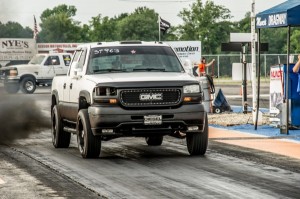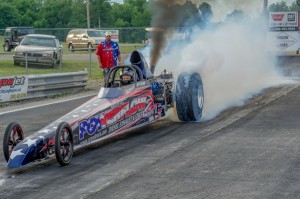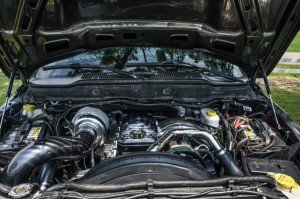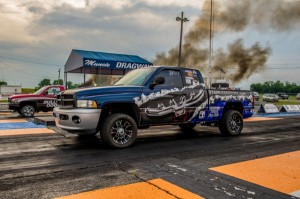DIESEL Motorsports began 13 years ago in Muncie, IN, where the first “diesel only” event was put together by a local TDR Club and two promoters.
Organizers held the event because the drag strips at that time would not let diesel trucks run on their tracks. In fact, they still do not have diesel classes for the trucks.
The truck enthusiasts also got the snub from tractor clubs. Local tractor pulling clubs back then would not let diesel trucks pull or get paid at local fairs, pulls and club events.
But, that has changed over the past decade, and now you can find diesel truck pulling/drag racing from June 1st to August 30th – pretty much every night of the week – from Missouri all the way over to the far edges of Pennsylvania.
For now, DIESEL Motorsports is predominate in the Midwest states, mostly because diesel trucks are used in farming, construction, hauling and automotive.
It started when diesel enthusiasts took their work trucks and started playing around with the engine components that produce more power. Hotter injectors, turbos, pumps, tuning, air intake and exhaust can produce double and now even triple the horsepower of the OEM diesel engine.
Some of the diesel enthusiasts use their truck on the job during the week, then race it on the weekends.
Photos in this article courtesy of DIESEL Motorsports/Eric Sullivan.
Ten years ago, the top diesel trucks competing were 800-900 horsepower. Today, they are 1,500-2,100 horsepower. The technology has blossomed within these diesel shops and many of their advancements are now available in the marketplace. Just like the early gas hot rod market, many of the diesel advancements will find their way to the OEM vehicles in the near future.
Customer Profile
A street diesel truck for our diesel enthusiasts is a typical 600-800 hp engine, getting 18-21 mpg and pulling a 10,000 lb. trailer for work. When it’s time to “play,” the owner can unhitch, go the track on the weekends and pull or race down the tracks.
Diesel truck motorsports has become a lifestyle within this industry – hard working, family–oriented, rural people who come to the events where they enjoy the time with their families in a fair-type atmosphere.
Spectators and competitors will back their truck up to the track, put chairs in the beds, put a pop-up canopy over them and get out the coolers/grills for the event. They can talk with each other and view what other people have done to their trucks. It’s a social event for each area of the country, and these trucks do differ state to state.
It’s a split crowd in age, 55% is the 20-30 year-old crowd, and the 35-50 year-old group is about 40% of the marketplace.
 Sled pulling makes up about 70% of the DIESEL Motorsports competitors with the remaining 30% as diesel drag racing.
Sled pulling makes up about 70% of the DIESEL Motorsports competitors with the remaining 30% as diesel drag racing.
The competitor’s percentage for the sport change from state to state, but in the Midwest where most diesel performance is predominate, the above percentages apply.
One of the reasons pulling is more popular is because pulling has been around at county fairs for many years starting with horses. Plus all it takes is a dirt track, some tractors to scrape the dirt and you are pulling.
Drag racing obviously requires an established track, which is quite expensive to operate and requires classes or events to run the diesel trucks.
Most diesel truck owners have pulled a trailer and are familiar with what it takes to pull under load. It does take some training and experience to win at drag racing along with having a powerful diesel truck.
It is no surprise that DIESEL Motorsports’ largest events are in Indiana, Ohio and Pennsylvania. The rural communities in the states make it very popular along with having the three diesel OEM engine plants in Indiana and Ohio.
 Since the EPA has shut down the use of tuners for the newer trucks (2008 and up), most diesel shops have gone back to enhancing the power using engine components instead of the electronics. This should have been done first, but it was pretty cheap to add a tuning box and crank up the power. However, most OEM drivetrain parts could not handle the extra power and blew apart.
Since the EPA has shut down the use of tuners for the newer trucks (2008 and up), most diesel shops have gone back to enhancing the power using engine components instead of the electronics. This should have been done first, but it was pretty cheap to add a tuning box and crank up the power. However, most OEM drivetrain parts could not handle the extra power and blew apart.
Before one can add power to a OEM diesel engine, there are certain things an engine builder needs to do to reinforce the powerplant – such as stronger head studs, gaskets, stronger rods, high-performance pistons, and other components because of the torque produced by the extra horsepower.
Most enthusiasts will quickly add-on a larger air intake system, exhaust system, turbo, injectors, injection pump and fuel pump in order to obtain more power.
If you are building a performance diesel, don’t forget to address with the customer the truck’s transmission and driveline, which will have a hard time keeping up with higher hp and torque. Some of the pulling trucks quickly went from double clutches to triple clutches in order to hold the power and transfer it to the driveline.
Popularity Contest
 Hands down, the Dodge/RAM truck is the most popular for competitors with the GM Duramax following behind in 2nd place. The Cummins engine is the most durable for making modifications and staying together be it the 5.9L or the newer 6.7L. Many of the competitors have even gone back to the 12 valve Cummins because of the mechanical tuning as opposed to electronic tuning on the newer engines.
Hands down, the Dodge/RAM truck is the most popular for competitors with the GM Duramax following behind in 2nd place. The Cummins engine is the most durable for making modifications and staying together be it the 5.9L or the newer 6.7L. Many of the competitors have even gone back to the 12 valve Cummins because of the mechanical tuning as opposed to electronic tuning on the newer engines.
Duramax is quickly catching up in pulling and racing with twin turbo kits becoming more and more popular for adding the extra power. There are several enhancements being made to the Duramax that makes it a close 2nd contender.
You will find many Ford diesels in the crowd and parking lot, but not too many on the tracks. The Ford OEM components for diesels are only rated to handle about a 13% increase in power without modifications, where the Dodge is about 40% and the Duramax at 30%. Quite a difference there with what you start out with for engine durability using increased horsepower components.
So, is there money to be had for diesel race engine building? You bet there is, since most of these enthusiasts are getting these trucks with 150,000-200,000 miles on them. Yes, a diesel will last longer, but with added power they will come apart and they will need to be repaired.
The opportunity lies in a performance rebuild instead of an OEM rebuild! There will be more money in it and higher profits with the custom parts. Build as if the engine could easily handle 700-900 hp, then you know it will withstand the added performance components.
Our goal eight years ago was to take diesel truck racing and pulling into mainstream sports. We still have a way to go, but it is getting noticed by a lot of auto sports enthusiasts.
This sport of diesel pickup pulling and racing is not going to go away anytime soon, by all indications it is going to be alive and kicking in the rural communities.
For more information on DIESEL Motorsports go to www.DIESELmotorsports.US
The post Diesel Motorsports Grow in Popularity appeared first on Engine Builder Magazine.
Read more here: Engine Builder Magazine

